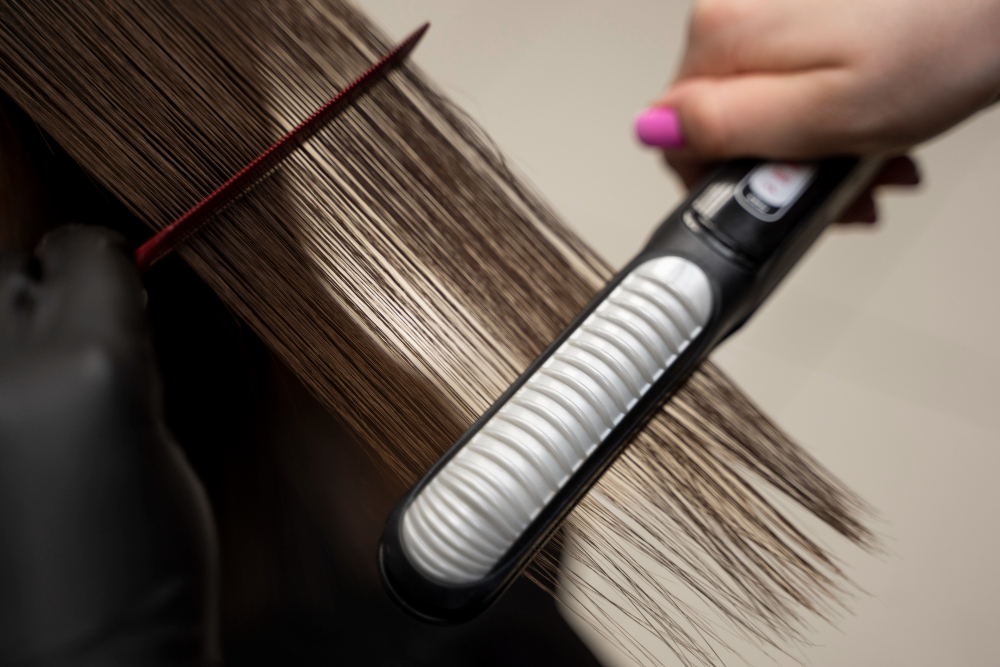You want smooth, shiny hair but struggle with frizz, curls, or waves that make styling a daily challenge.
With so many treatments available, especially Keratin Treatment vs Japanese Straightening, it is hard to decide which approach is right for your hair.
Choosing the wrong option can lead to disappointing results or even damage. Without proper guidance, you risk wasting time and money, and your hair may not achieve the sleek, frizz-free look you’re hoping for.
Our guide explains everything about Keratin Treatment vs Japanese Straightening—from results, duration, and cost, to suitability and aftercare—so you can confidently choose the best treatment for your hair type.
By following this guide, you’ll understand the key differences and benefits of each method, allowing you to enjoy healthy, smooth, and frizz-free hair that suits your lifestyle.
Quick Summary of Key Differences
| Feature | Keratin Treatment | Japanese Straightening |
|---|---|---|
| Permanent or Semi-Permanent | Semi-permanent | Permanent |
| Damage Level | Low to moderate | Moderate to high |
| Styling Flexibility | Can style with tools | Difficult to curl after |
| Maintenance | Reapply every 3–5 months | Touch-ups for new growth every 6 months |
| Cost | $150–$400 | $300–$600+ |
| Hair Types | Most hair types | Healthy, stronger hair |
| Duration of Results | 2–5 months | 6–12 months |
What is Japanese Hair Straightening?

Japanese hair straightening, also called thermal reconditioning or the Yuko system, is a permanent hair straightening method. It restructures your hair’s internal bonds, leaving it sleek, shiny, and frizz-free.
Steps of Japanese Straightening
- Hair Consultation & Analysis: A stylist evaluates hair type, texture, and past chemical treatments to customize the process.
- Application & Straightening Process: A chemical solution softens hair bonds, followed by blow-drying and flat-ironing to achieve straight hair.
- Neutralization, Rinsing, and Blow-Dry: A neutralizer locks the hair’s new structure in place. Hair is rinsed and blow-dried to reveal straight, glossy results.
| Pros | Cons |
|---|---|
| Ultra-smooth, polished hair | Chemical exposure risk |
| Long-lasting (up to 12 months) | Permanent result, no natural curl return |
| Low maintenance | Root touch-ups every 6 months |
| Cuts down styling time | Harder to re-curl |
| Some see healthier hair post-treatment | Not ideal for color-treated hair with red/henna tones |
| Confidence booster for frizz-prone hair | Higher upfront cost |
Safety & Damage Considerations
Japanese straightening is safe when performed by professionals, but may damage hair if applied to already weak or chemically treated strands.
What is a Keratin Treatment?

Now, we focus on what we do best here at Haste Urban Hair Spa, the Keratin treatment. A Keratin treatment is a semi-permanent smoothing method that coats hair with keratin proteins, reducing frizz, improving shine, and enhancing manageability without permanently altering hair structure.
🧴 Learn more about keratin treatments here.
Steps for a Keratin Treatment
- Hair Analysis & Consultation
Determine hair health and suitability for the treatment. - Application & Blow-Dry / Flat Iron
The keratin solution is applied, processed, and sealed with a flat iron. - Post-Treatment Care
Hair should not be washed for 72 hours. Results last approximately 2–5 months.
| Pros | Cons |
|---|---|
| Smooths and softens hair | Wears off in 3–5 months |
| Easier styling, less daily effort | May contain strong chemicals |
| Semi-permanent | Requires specific aftercare products |
| Works on most hair types | Reapplication needed to maintain results |
| Improves manageability | Higher cost for professional treatments |
Safety & Damage Considerations
Keratin treatments are generally safe for most hair types and cause minimal damage when applied by a professional.
Keratin or Japanese Straightening: Is It Right for Your Hair?

When it comes to Keratin Treatments vs Japanese Atraightening, it ultimately comes down to personal preference. But if you’re undecided, then consult with one of our stylists if you have:
- Recently dyed, bleached, or henna-treated hair
- 70%+ gray or previously colored hair
- Fine or delicate hair
- African American hair with varying curl patterns
👀 Did you know you also get a straight perm that is different from a Japanese or keratin treatment? Learn more bout it here.
🧴 Also, explore the Hair Botox Treatment
Aftercare for Long-Lasting Results
When it comes to Keratin Treatment vs Japanese Straightening, both treatments work well for those with frizzy, curly, or wavy hair who want to achieve smooth, straight hair. The aftercare is also similar:
- Do not wash hair for at least 72 hours
- Use sulfate-free shampoo and conditioner
- Avoid chemical treatments for 2–3 weeks
- Schedule regular trims for split ends
- Use anti-humidity styling products
🧴 Additionally, learn more here about the glass hair look to give your hair a mirror-shine finish, as well as retexturizing treatments.
🧴 Did you know that you can also have a keratin express treatment that takes less time to do compared to a keratin treatment? Learn more here.
Keratin Treatment vs Japanese Straightening
Choosing between a Keratin treatment and Japanese hair straightening depends on your hair goals, daily routine, and willingness to commit to long-term results.
If you want smoother, frizz-free hair while preserving your natural wave and flexibility, opt for a Keratin treatment that provides low-damage, semi-permanent results with minimal risks.
Yet, if your goal is to achieve very straight hair with minimal styling, we recommend the Japanese straightening option. However, ensure your hair is healthy enough to handle the strong chemicals.
No matter which you choose, professional guidance is essential. At Haste Urban Hair Spa, we’re here to help you make the best decision for your hair’s health and personal style.
FAQ
Can I switch from a Japanese straightening to a Keratin treatment?
Yes, but you must wait 6–8 months after your last Japanese straightening session and consult with a stylist. Combining treatments too soon can damage your hair.
Will either treatment eliminate frizz?
Keratin significantly reduces frizz but doesn’t eliminate it. Japanese straightening permanently straightens hair, eliminating frizz.
Can I color my hair after getting either of these treatments?
Wait at least 2–3 weeks after treatment before coloring your hair for optimal results. Japanese straightening can be more reactive to color, so it’s always best to consult a professional.
Which treatment is safer for damaged or color-treated hair?
Keratin treatments are safer for color-treated or mildly damaged hair, as they are less harsh and more conditioning than Japanese straightening.
Is Japanese hair straightening safe for fine or weak hair?
It may cause damage; professional consultation is essential.









